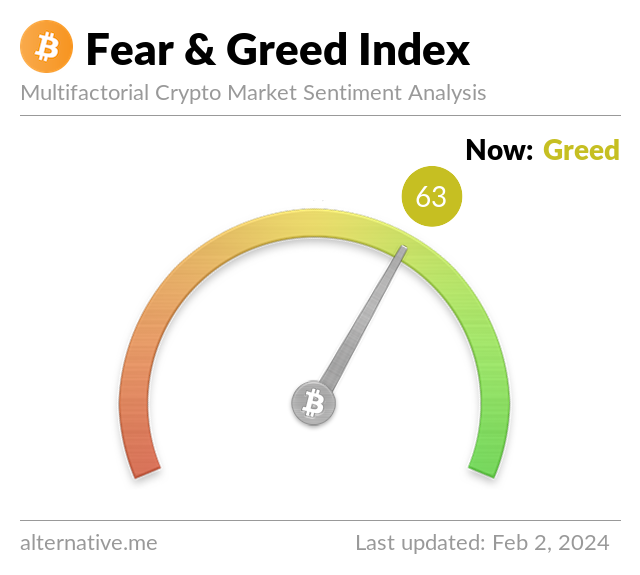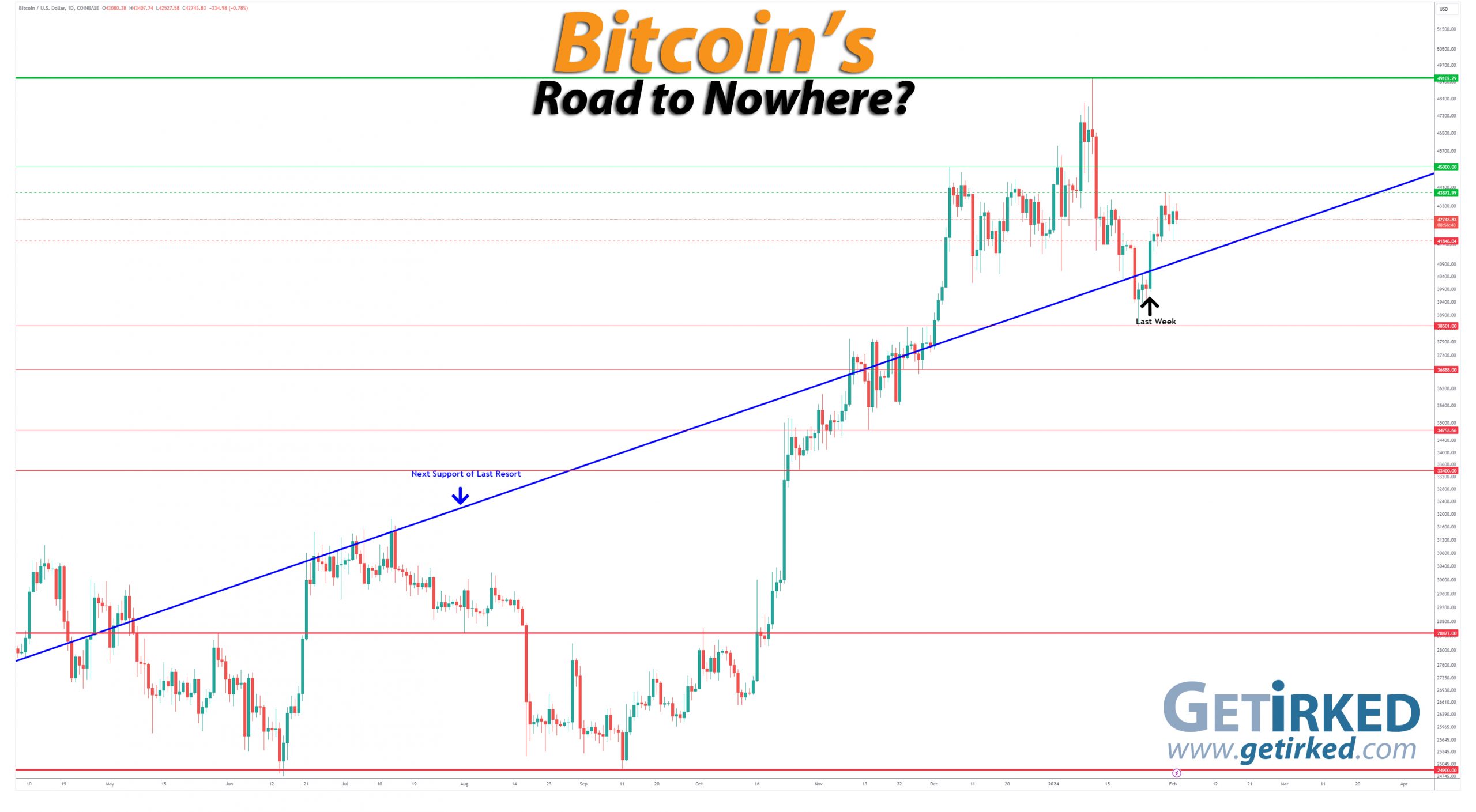Summing Up The Week
Initially, the rally we’d seen for the majority of January continued to kick off the week until Federal Reserve Chairman Jerome Powell threw water on the markets during his press conference on Wednesday when he said a March rate cut was unlikely.
There were also mixed reports showing a resilient economy in terms of the consumer but an economy in signs of recession in terms of manufacturing. Finally, Friday brought the jobs report which showed the labor market remains strong and resilient. The rally regained its steam on Friday following the nonfarm job report and the excellent tech earnings delivered Thursday evening.
Let’s take a look at the news that moved the markets…
Market News
U.S. Treasury to borrow less than expected in Q1
The markets exploded higher on Monday following news that the U.S. Treasury expects to borrow $760 billion in the first quarter of 2024, $55 billion below the estimate from October, reported Reuters. The announcement caused the 10-Year Treasury yield to drop and gave the green light to stocks to take off, which they did with the S&P 500 finishing the day up more than 0.75% despite rallying hugely last week, too.
Some level-headed pundits tried to offer a cooler perspective on the situation. “The market moved on this information which just shows you how sensitive it is to refinancing estimates,” said Gennadiy Goldberg, head of U.S. rates strategy at TD Securities in New York. “But historically these estimates don’t mean very much except for potentially, marginally less bill supply in the short term.”
Consumer Confidence highest in two years
On Wednesday, the Consumer Confidence Index increased to 114.8 in January from 108.0, the highest reading for the survey since December 2021, reported Investopedia. Given that consumer spending accounts for about 70% of U.S. economic growth, a confident consumer is a welcome sign of a healthy and resilient economy.
“Consumer confidence surveys have gradually edged higher as consumers acknowledge the deceleration of inflationary pressures, interest rates inching lower and a stronger stock market supporting their pensions,” said Quincy Krosby, LPL Financial chief global strategist.
Chicago PMI falls further into contraction
Countering the last week’s services and manufacturing Purchasing Managers’ Indexes (PMI), the Chicago Business Barometer, also referred to as the Chicago PMI, fell 1.2 index points to 46 in January versus economists’ expectations for an increase to 48 on Wednesday, reported MarketWatch. A falling reading indicates that businesses are in contraction, spending less in order to prepare for potential lack of growth (recession) in the economy.
Fed Chief Jerome Powell says rate cut in March “not likely”
On Wednesday, Federal Reserve Chairman Jerome Powell warned that a highly-anticipated rate cut in March would not be likely, reported CNBC. An interest rate cut would have been seen as a positive sign for stocks as it would lower the cost of borrowing for any companies taking on debt. As a result, the stock market sold off significantly with the S&P 500 dropping more than -1.60% on the day and the Nasdaq falling more than -2.20%.
“Based on the meeting today, I would tell you that I don’t think it’s likely that the committee will reach a level of confidence by the time of the March meeting to identify March as the time to do that. But that’s to be seen,” said Powell in his press conference.
I was relieved that Powell came out hawkish. The markets had gotten so frothy with the indexes making new all-time highs on a daily basis, that the lack of a pullback could have resulted in a more significant crash. In other words, had Powell juiced the market even higher, the eventual pullback would be much worse. Even now, I think the market is due for a 10% drawdown or greater. Whether we will actually get one before heading higher remains to be seen.
ISM Factory index improves but still in contraction
On Thursday, the Manufacturing Institute for Supply Management Report on Business (referred to as “ISM), showed an increase to 49.1% in January from 47.1%, better than the 47.2% expected by economists, but still in contraction, reported MarketWatch. Any reading below 50% indicates that the economy is receding, not growing.
Economists believe the worst has passed, but that it will be some time before we see a genuine recovery. “In short, the manufacturing sector appears to be past the worst, but we see few signs of a raging rebound looming in the data; a gradual further uptrend in activity is a more reasonable bet,” said Ian Shepherdson, Chief Economist at Pantheon Macroeconomics.
U.S. adds 353K jobs in January, much better than expected
On Friday, the nonfarm payrolls showed an expansion of 353,000 jobs in January, far higher than the 185,000 expected by economists with the unemployment rate holding steady at 3.7% versus 3.8% expected, reported CNBC. The data reinforces statements made by Powell on Wednesday that with the economy this strong and resilient, to cut interest rates in March would be imprudent.
“Make no mistake, this was a blowout jobs report and will vindicate the recent posturing by the Fed which effectively ruled out an interest rate cut in March,” said George Mateyo, chief investment officer at Key Private Bank. “Moreover, strong job gains combined with faster than expected wage gains may suggest an additional delay in rate cuts for 2024 and should cause some market participants to recalibrate their thinking.”
Despite this being a “good news is bad news” situation, the markets continued their explosive rally on the back of outstanding earnings from Meta (META) and Amazon (AMZN) after the bell on Thursday.
Next Week’s Gameplan
This week was filled with catalysts, but next week is relatively light with just a few reports which may or may not have much effect on stocks. Earnings season continues, so we may see stock- or sector-specific catalysts moving certain parts of the market one way or the other.
For right now, the Bulls maintain a tight grip on the market, and it feels like the rally has legs. That doesn’t mean I don’t plan for the downside, but I do re-evaluate all of my buying price targets and raise those that I think aren’t aggressive enough given how so many participants seem to be buying every dip.
As always, make your plan in advance and don’t be afraid to pull the trigger on quality long-term holdings at discounted prices.
I’ll see you all back here next week, friends!
This Week in Play
Stay tuned for this week’s episodes of my two portfolios Investments in Play and Speculation in Play coming online later this weekend!
Crytpo Corner

Bitcoin Price (in USD)
%
Weekly Change
Bitcoin Price Action
Has the Bitcoin selling finally stopped?
Bitcoin rallied with gusto through the Next Support of Last Resort, not even using it for support for rallying to a new weekly high at $43,872.99 on Tuesday. The crypto rolled over and sold off going into the end of the week, making a new weekly low at $41,846.04.
Pundits pointed to Grayscale’s Bitcoin Trust (GBTC) as the biggest drag on Bitcoin’s price since the launch of the ETFs. Grayscale’s annual fee was substantially higher than the other ETFs at 1.60% (versus most of the other ETFs which are priced between 0.20-0.25%).
As a result, when the ETFs were launched, GBTC investors pulled out in droves, causing GBTC to sell Bitcoin and drive down the price of the underlying asset.
The Bullish Case
Bulls believe we’ve seen the end of the GBTC outflows and that Bitcoin will consolidate at these levels before breaking out and heading higher. Many Bulls have been giving calculations of how much Bitcoin the ETFs will swallow up and suggest that the next bull market is already underway.
The Bearish Case
Bears point to the relative strength of tech stocks versus Bitcoin since the start of the year. Typically, there’s a strong correlation between Bitcoin and high-growth stocks where both move in tandem. However, since the start of the year, megacap stocks are higher and Bitcoin’s under selling pressure. Bears predict that the correlation will reengage on the downside, suggesting that when the stock market pulls back, so will Bitcoin.
The usual downside price targets are incredibly dour with Bears arguing that a retest of $38,501.00 is a certainty and that Bitcoin will crash to $32,000, at least, before finding any support. Time will tell.
Bitcoin Trade Update
Current Allocation: 2.767% (+13.73% since Last Update)
Current Per-Coin Price: $45,181.62 (-0.85% since Last Update)
Current Profit/Loss Status: -5.40% (+4.10% since Last Update)
Whenever Bitcoin finds support and rallies, I re-engage buy orders at past levels of support. This might seem counterintuitive to some who would prefer to wait for the asset to break to new lower-lows before adding, but I mitigate risk by continuing to buy incredibly small quantities.
I always want to continue adding at levels of support just in case the Bulls are right and we’re headed into a new Bull Market. However, I also add small in case the Bears are right and we get better buying opportunities in the future.
I made 11 buys over the past week ending with an average buying price of $42,540.16 (after fees). The buys lowered my per-coin cost -0.85% from $45,569.23 down to $45,181.62 and increased my allocation +13.73% from 2.433% to 2.767%.
Bitcoin Buying Targets
Using Moving Averages and supporting trend-lines as guides, here is my plan for my next ten (10) buying quantities and prices:
0.027% @ $42,387
0.027% @ $42,152
0.027% @ $41,987
0.027% @ $41,566
0.027% @ $41,310
0.027% @ $41,007
0.054% @ $40,682
0.054% @ $40,358
0.082% @ $40,089
0.082% @ $39,627
Not Your Keys, Not Your Crypto…
In light of brokerage failures in 2022, I no longer keep any of my crypto on an exchange and I only keep enough USD on the exchanges I use to execute my next few buys. I use multiple cold wallets from the brands Ledger and Trezor to hold my crypto (click the links to access the direct sites, and I receive no affiliate benefits from these links).
Additionally, I have now divided my allocated USD between two different exchanges – Gemini and Coinbase – in case one (or both) becomes insolvent. Disclaimer: We both receive a bonus if you use my Gemini referral link to open an account.
I do not trust anyone in the space, even with Coinbase (COIN) being publicly traded (and one of my own Investments in Play positions).
No price target is unrealistic in the cryptocurrency space – Bullish or Bearish.
While traditional stock market investors and traders may think the price targets in the cryptocurrency space are outlandish due to the incredible spread (possible moves include drops of -90% or more and gains of +1000% or more), Bitcoin has demonstrated that, more than any speculative asset, its price is capable of doing anything.
Here are some of Bitcoin’s price movements over the past couple of years:
- In 2017, Bitcoin rose +2,707% from its January low of $734.64 to make an all-time high of $19,891.99 in December.
- Then, Bitcoin crashed nearly -85% from its high to a December 2018 low of $3128.89.
- In the first half of 2019, Bitcoin rallied +343% to $13,868.44.
- In December, Bitcoin crashed -54% to a low of $6430.00 in December 2019.
- In February 2020, Bitcoin rallied +64% to $10,522.51.
- In March , Bitcoin crashed nearly -63% to a low of $3858.00, mostly in 24 hours.
- Then, Bitcoin rallied +988% to a new all-time high of $41,986.37 in January 2021.
- Later in January 2021, Bitcoin dropped -32% to a low of $28,732.00.
- In February, Bitcoin rallied +103% to a new all-time high of $58,367.00.
- Later in February, Bitcoin dropped -26% to a low of $43,016.00.
- In April , Bitcoin rallied +51% to a new all-time high of $64,896.75.
- In June , Bitcoin crashed -56% to a low of $28,800.00.
- In November, Bitcoin rallied +140% to a new all-time high of $69,000.00.
- In November 2022, Bitcoin crashed -78% to a low of $15,460.00.
- In April 2023, Bitcoin rallied +101% to a high of $31,050.00.
- In June, Bitcoin dropped -20% to a low of $24,750.00
- In July, Bitcoin rallied +29% to a high of $31,862.21.
- In September, Bitcoin dropped -22% to a low of $24,900.00.
- In January 2024, Bitcoin rallied +97% to a high of $49,102.29.
- Later in January, Bitcoin dropped -22% to a low of $38,501.00.
Where will Bitcoin go from here? Truly, anything is possible…
What if Bitcoin’s headed to zero?
The only reason I speculate in the cryptocurrency space is I truly believe Bitcoin isn’t headed to zero. I am prepared for that possibility, however, by knowing I could potentially lose all of the capital I’ve allocated to this speculative investment. Professional advisers recommend speculating with no more than 5% of an investor’s overall assets. Personally, I’ve allocated less than that to speculating in crypto. I feel that anyone who doesn’t fully believe in the long-term viability of cryptocurrency would be better served not speculating in the space. On a good day, this asset class isn’t suitable for those with weak stomachs. On volatile days, the sector can induce nausea in the most iron-willed speculator. If a speculator isn’t confident in the space, the moves will cause mistakes to be made.DISCLAIMER: Anyone considering speculating in the crypto sector should only do so with funds they are prepared to lose completely. All interested individuals should consult a professional financial adviser to see if speculation is right for them. No Get Irked contributor is a financial professional of any kind.


